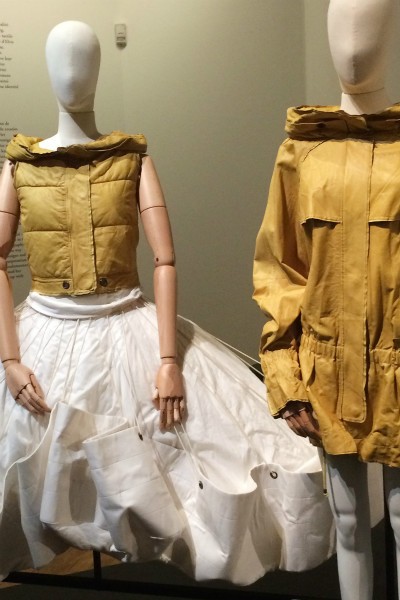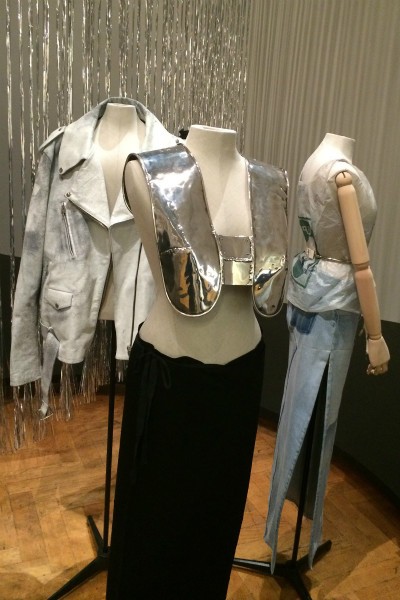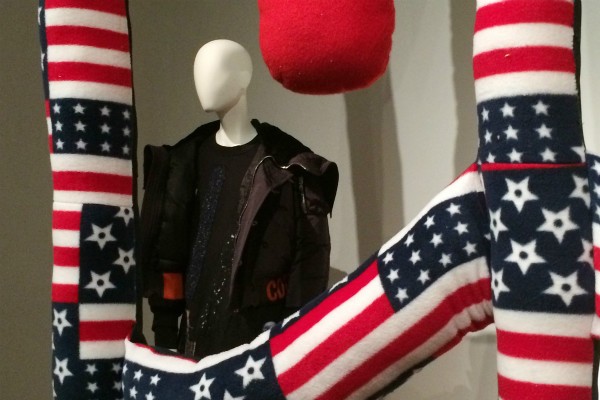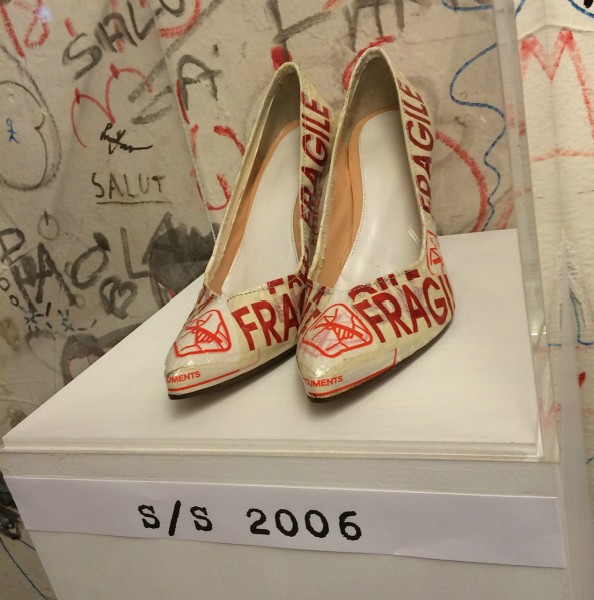比利时风尚:意想不到的时装故事
那是喜剧演员口中的段子吗——除了每天喝啤酒、吃青口和薯条,他们就只能调侃一下自己国家的时装潮流?
或者是对巴黎时装的模仿——专为上流社会的比利时皇亲国戚和布鲁塞尔人而设计?
还是个性活力的亲弗拉芒年青一代的叛逆呐喊——也想对八十年代的时装发表自己的看法?

布鲁塞尔Bozar艺术中心,比利时设计师的人形模特大军
我这样定义比利时时装设计师:喜欢改造服饰,衣服接缝不经拷边、剪裁过大,拥有理性的态度,以朴素却冲击视觉的设计对抗着八十年代的奢华风潮。不过我很难相信,这些设计师们竟在约30年前就已崭露头角。
1986年,创意十足的“安特卫普六君子”获得了巨大成功,时至今日,比利时人似乎仍觉得他们很神秘。所以,在布鲁塞尔的Bozar艺术中心举行的最新时装展才会有这样一个名字——“比利时风尚:意想不到的时装故事”(展期至9月13日)。
一个在法语与弗拉芒语所代表的文化群体之间寻求政治平衡的国家,竟涌现出一股追求改变的新锐势力,这真的算是意外吗?安特卫普的叛逆与同时期东京设计师们对日本传统的挑战,难道不是如出一辙?
这场布鲁塞尔时装秀——神秘动人,有时甚至惊艳四座;同时却也令人费解、一反常规——这或许能让业内人士们更多地了解到弗拉芒人面对瓦隆人时的尴尬境遇。但在我看来,这是一个错失的机遇——比利时风尚本可在此被定义为一个独立风格或流派;从这些时装作品的颜色和材质中,甚至可以看到以Pieter Bruegel为代表的早期弗拉芒艺术家们对其产生的影响。

Olivier Theyskens设计的服装在布鲁塞尔Bozar艺术中心展出
街边巨大的玻璃橱窗里,展示着布鲁塞尔的标志性元素,从各式各样的旗帜到为1958年世博会所建的原子球塔,不一而足。而我,从这些橱窗前径直走过,直奔Bozar艺术中心,去欣赏策展人Didier Vervaeren的绝妙想法:一群身着时装的人形模特大军蒙着似乎只在医院里才看得到的白色头巾(这或许是想向Martin Margiela和他的员工们穿的实验室服致以敬意吧)。
站在最前面的时装“武士”穿的,是较为传统的设计师们设计的端庄干练系列的服饰,他们鲜为国际时装界所知。而站在队列正中间的,就是名望极高的“安特卫普六君子”——Dries Van Noten、AnnDemeulemeester和Walter Van Beirendonck设计的服饰, 这些名字让世界第一次对比利时时装设计产生了兴趣。
队列的后排还陈列了很多其他设计师的作品,比如Kris Van Assche、Gerald Watelet和他优雅的定制服装,还有HaiderAckermann,从一定意义上说他也算是位比利时设计师,因为他曾在安特卫普皇家艺术学院就读了三年。
“隐形”设计师Margiela堪称时装界的重建与解构主义之父。他是这次展览的主角。在一面银色缎带幕墙后,有一块区域专门陈列他的改造服饰,三只袖管的夹克外套、分趾鞋均位于其中。Margiela大概是历史上第一位反对时装浪费、践行环保的激进设计师,与当今快销时尚的主流形成鲜明对比。展览中却缺少能突出体现Margiela这项身份作用的录像或电子图片。

Martin Margiela的解构与再生服饰
然而,展览上还有一块更大的区域,献给了时下潮流设计师——一群致力于“更绿色,更环保”理念的时装设计师。
如此看来,这次展览并没有体现出比利时设计师们的新突破,倒更像一场对于过去事物的沉痛追思。
流言传说,Margiela于2009年将自己的同名品牌卖给了意大利品牌Diesel创始人Renzo Rosso的控股公司Only theBrave,随后悄悄离开。但我并没有在任何地方看到这样的确切消息。所谓John Galliano已经接替Margiela成为Maison Margiel的设计师也不属实。展览更没有提到Margiela在Hermès的工作岁月(1997-2003)。
比利时设计师的影响力之大,从其设计师逐渐融入巴黎时装潮牌这一点中可见一斑。Raf Simons一边经营着自己的比利时男装品牌,同时身兼Dior的新任创意总监。为了呼应《迪奥与我》这部时装纪录片,他的高级定制服装在Bozar艺术中心应该也是值得一秀的。可展出的,却是搭配艺术家Sterling Ruby红白蓝三色旗的Raf Simons男装,真是非比寻常。

一件Raf Simons男装与SterlingRuby的艺术作品
同样,Kris Van Assche自2007年起就一直担任DiorHomme的创意总监,经典法国时装老牌的设计全部交到比利时人的手中。这绝对值得庆贺!只是Van Assche近日决定关闭自有同名品牌,看来获得国际性的成功是要付出一定代价的。这个话题其实很值得讨论一番。
另一位在国际时装界拥有一席之地的设计师无疑当属Dries Van Noten。他的服装设计连同装饰艺术作品展已从巴黎的装饰艺术博物馆(Musée des Arts Décoratifs)搬到了安特卫普。此次Bozar艺术中心展览里,Van Noten确有几件成衣展出,还有一个小屏幕展示他在舞蹈装束方面的合作设计作品。但那能为他吸引来重量级博物馆收藏品的国际声誉却没让他在这次展览中变得“值得一提”。
本次展览聚焦了不少时尚圈人士。尤其突出的有Ann Demeulemeester和她典雅的深色时装;而OlivierTheyskens凭借他那极具诗意的想象先后赢得了巴黎高级定制和美国快销时尚的舞台。然而,策展人也未对这位设计师艰辛漫长的成功之路作丝毫评论。
好的方面自然也是有的。出生于比利时并在那里度过童年的设计师Diane von Furstenberg虽是在美国创立了自己的时装品牌,但她多姿多彩的裹身裙与展览开幕式上充满活力的形象,让她为时尚界作出的贡献当场立现生机。
展览中给人印象最深刻的是一些小房间——设计师们的个性、风格、特点都在那些小房间里以视觉形式呈现。A.F. Vandevorst的空间设计得十分夺目,小房间里摆了一张床,床上有设计师们亲笔签的红十字;Jean-Paul Lespagnard通过围巾和新潮独特的玻璃瓶呈现自己的造型;Raf Simons展示了一幅个人肖像;Dries Van Noten则用自己时装秀的图片,嵌上底片,装饰了一面墙。

用透明胶带制作的细高跟女鞋,MaisonMartin Margiela 2006春/夏系列
教育是比利时时装史中不可或缺的部分,布鲁塞尔的La Cambre建筑与视觉艺术学院和安特卫普皇家艺术学院就是培育时装大师的温床。此次展览很大一部分区域展出的都是在读学生们的设计与绘画作品。
人形模特大军中还有一条队列属于包括Anthony Vaccarello和Vetements团队在内的新晋设计师们,他们中大多数都在Maison Margiela历练过。
我建议对比利时时装感兴趣的人最好沿着设计狂人们铺下的道路走走,去Dansaert区Antoine街上看看,逛逛刚毕业的设计师们开的各式各样的小服装店。
Dansaert区最酷的地方就是Flandre街114号的Maison MargielaBrussels时装店,在那里,Margiela执掌品牌时的经典作品与当代设计完美融合。Marché街4号,一位名叫Linder的艺术家与隔壁DépendanceGallery画廊合作呈现了一场美妙绝伦的展览。她借用Maison Margiela Brussels私家收藏的经典单品,制作出各种多媒体装置——而这充满艺术与智慧的作品,才是我期待在Bozar展览上看到的设计。
Is it a source of jokes for comedians – to add to the clichés of beer, mussels and fries?
Could it be just a polite imitation of Parisian fashion for the Bruxelloise and the Belgian royal family?
Or the rebel yell of a young, dynamic, Flemish-leaning group who made a statement about fashion in the Eighties?

Army of Belgian designers at Bozar Brussels
I think of recycling, raw seams, oversize cutting and a cerebral attitude as a definition of Belgian fashion designers, who offered a modest but forceful vision to face off the extravagant Eighties. But I can barely believe that these designers first appeared almost 30 years ago.
The success of the original Antwerp Six in 1986 seems still to mystify its own country, hence the title of a new exhibition at the Bozar– Centre for Fine Arts – in Brussels: The Belgians: An Unexpected Fashion Story (until September 13).
Was it really such a surprise that a country searching politically for a balance between its French and Flemish sides should produce a youthful urge for change? Wasn’t the rebellion in Antwerp equivalent to the Tokyo designers whochallenged Japanese convention during the same period?
The Brussels show – intriguing, occasionally striking, but also confusing and inconsistent – probably tells insiders a lot about the discomfort of the Flemish rubbing up against the Walloons. But to me, it was a missed opportunity to define Belgian fashion as an entity; or even to link the work, in colour or texture, to the influence of early Flemish artists such as Pieter Bruegel.

Olivier Theyskens outfits at Bozar Brussels
I walked right past big windows showing symbols of Brussels, from flags to the famous metal Atomium of Expo 1958. I was heading for curator Didier Vervaeren’s best idea: an army of designer outfits, the mannequins’ heads covered with white“hospital” headpieces (perhaps a homage to the lab coats worn by Martin Margiela and his staff).
The first of these fashion“soldiers” are the more traditional designers who dressed class and court and rarely had international recognition. But at the centre of the line-up are the famous Antwerp Six whose names, from Dries Van Noten to Ann Demeulemeester to Walter Van Beirendonck, first triggered interest in Belgian design.
The continuing line-up includes many names, from designer Kris Van Assche through Gerald Watelet and his graceful couture designs to Haider Ackermann, an honorary Belgian because he was at college in Antwerp.
Margiela, the“invisible” designer, who was fashion’s founding father of recycling and deconstruction, is the exhibition’s hero, with a section devoted – behind a“wall” of silver ribbons – to his recycled clothes, including a jacket with three arms and shoes shaped with toes. Margiela was perhaps the first designer to be an activist against fashion waste – the antithesis of today’s fast fashion. Missing was a series of videos or digitalised pictures that could have emphasised that role.

Martin Margiela deconstructed and re-used outfits
However, there is a strong section devoted to current designers with a commitment to a“greener” fashion universe.
Yet this exhibition seems more like a wistful memory of things past than Belgian designers in today’s dynamic.
Nowhere did I read that Margiela quietly left his namesake label in 2009, after selling his brand to Only the Brave, the holding company of Renzo Rosso of Diesel. Nor the fact that John Galliano has now taken over as Maison Margiela’s designer. Nor was there any mention of the Margiela years at Hermès (1997-2003).
The power of Belgian designers includes the infiltration of Parisian brands. Raf Simons, while continuing his own Belgian-based menswear label, is now creative director at Dior. To coincide with the current film, Dior and I, his couture work might have deserved a showing. But there is a striking display from a Raf Simons men’s show with the bold red, white and blue flag by artist Sterling Ruby.

A Raf Simons look with Sterling Ruby art
Similarly, Kris Van Assche has been artistic director of Dior Homme since 2007, putting the quintessentially French house’s design entirely in Belgian hands. A reason for celebration – except that Van Assche has recently decided to shutter his own label, showing that international success comes at a price. That should have been a subject worth discussing.
Another indisputably international designer is Dries Van Noten, whose exhibition of his designs, paired with artworks, has moved from the Musée des Arts Décoratifs in Paris to Antwerp. Van Noten’s international prestige that enabled him to attract loans from important museums does not receive a mention at the Bozar, although he has a few outfits on display and a small screen showing his collaboration on dance costumes.
The exhibition focuses on variousfigures in the fashion landscape: notably Ann Demeulemeester with her graceful, dark designs; and Olivier Theyskens, whose poetic vision landed him first in Paris couture and then in American fast fashion. Once again, there is no curatorial comment about the long, hard road to succeed in fashion.
On the bright side is Diane von Furstenberg, born in Belgium, where she spent her childhood. Although she built her brand in America, her colourful wrapdresses and her dynamic presence at the exhibition’sopening brought her contribution to life.
The most effective area displays small“cabins”, where designers have been invited to express their visual personalities: a striking A.F. Vandevorst space has a bed with the designers’ signature red cross; Jean-Paul Lespagnard expresses his look via scarves and funky bottles; Raf Simons shows a single portrait; and Dries Van Noten has a wall with pictures inset with films of his shows.

Stilettoes made from Fragile Sellotape from Maison Martin Margiela S/S 2006
Education is an important part of Belgian fashion history, with the La Cambre school in Brussels and Antwerp’s Royal Academy of Fine Arts considered as incubators of excellence. The curator brought in today’s students with their designs and drawings displayed over a large area.
There is also a line-up of the newer design generation, from Anthony Vaccarello to the Vetements team, mostly trained at Maison Margiela.
But my advice to those intrigued by Belgian design would be to follow a path laid by Mad – Mode and Design – to look at the Rue Antoine Dansaert which, along with the surrounding area, has a variety of small shops opened by recently graduated designers.
King of cool in the Dansaert district at number 114 Rue de Flandre is Maison Margiela Brussels, where vintage pieces from the designer’s years at the helm meld with current designs. A collaboration with the neighbouring Dépendance Gallery, at 4 Rue du Marché aux Porcs, produces a fascinating exhibition by a gallery artist known as Linder. She uses iconic pieces, borrowed from the private archives of Maison Margiela Brussels, as multimedia installations – just the artistic and intelligent display I might have expected to see at the Bozar exhibition.
网址:比利时风尚:意想不到的时装故事 https://mxgxt.com/news/view/1226266
相关内容
巴黎时装周揭幕:杨紫、张晚意、关晓彤各显风采,背后故事揭露时尚风潮意大利欧时力时装—明星注目的时尚焦点
时尚大师背后的故事
刘宇与林心如时装周同框,时尚背后的情感故事
红毯上的时尚故事,你知道多少?
女星投奔时装周 假时尚 真跟风
专业解析|当芭比来到现实,粉红风暴席卷时尚造型界—时尚专业
比基尼服装图片,性感与时尚的完美融合
美国时尚圈风云录:揭秘年度女星时尚排行榜背后的故事
揭秘时装秀幕后故事

